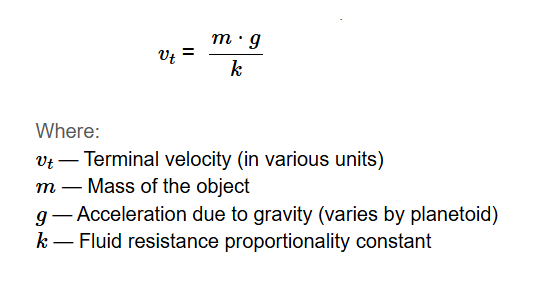 Home
Home
 Back
Back

Definition: This calculator computes the terminal velocity (\( v_t \)) of an object falling through a fluid, based on its mass (\( m \)), the acceleration due to gravity (\( g \)), and the fluid resistance proportionality constant (\( k \)).
Purpose: It is used in physics to determine the constant velocity an object reaches when the force of gravity is balanced by the drag force, applicable in studies of falling objects, skydiving, and fluid dynamics.
The calculator uses the relationship:
Where:
Explanation: Enter the fluid resistance constant, mass, and select the planetoid to determine the acceleration due to gravity. The calculator computes the terminal velocity. Results are displayed with 5 decimal places, using scientific notation if the value exceeds 100,000 or is less than 0.0001. For default inputs (\( k = 0.5 \, \text{kg/s} \), \( m = 1 \, \text{kg} \), planetoid = Earth (\( g = 9.81 \, \text{m/s}^2 \))), the calculated terminal velocity \( v_t \) is 19.62000 m/s.
Details: Calculating terminal velocity is essential for understanding the maximum speed an object can reach while falling through a fluid, aiding in the design of parachutes, aircraft, and other systems involving drag forces.
How do I find the terminal velocity of a falling object?
Measure the mass in kilograms, the fluid resistance constant in kg/s, and select the planetoid to determine the acceleration due to gravity. Compute the terminal velocity using the formula \( v_t = \frac{m \cdot g}{k} \). The result will be in meters/second.
What does terminal velocity represent?
Terminal velocity represents the constant speed an object reaches when the gravitational force is balanced by the drag force, meaning the object no longer accelerates and falls at a steady rate.
What is the formula for terminal velocity?
The formula for terminal velocity is \( v_t = \frac{m \cdot g}{k} \), where \( m \) is the mass, \( g \) is the acceleration due to gravity, and \( k \) is the fluid resistance proportionality constant. The standard unit for velocity is meters/second (m/s).